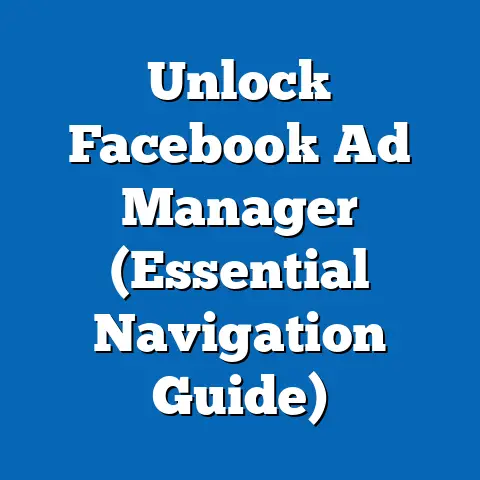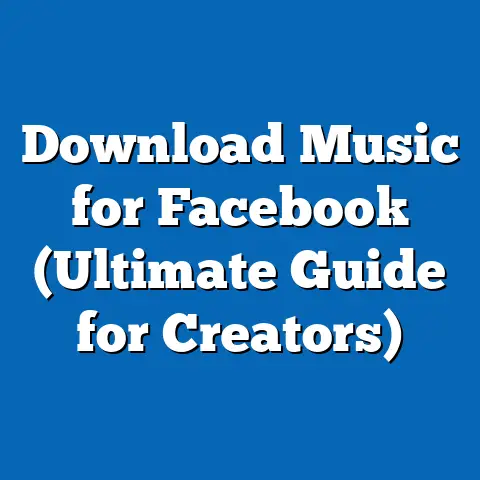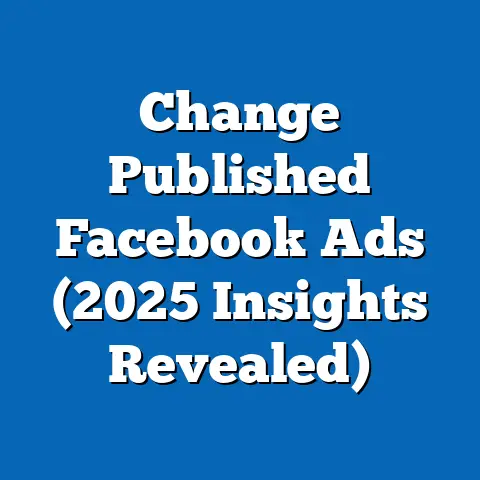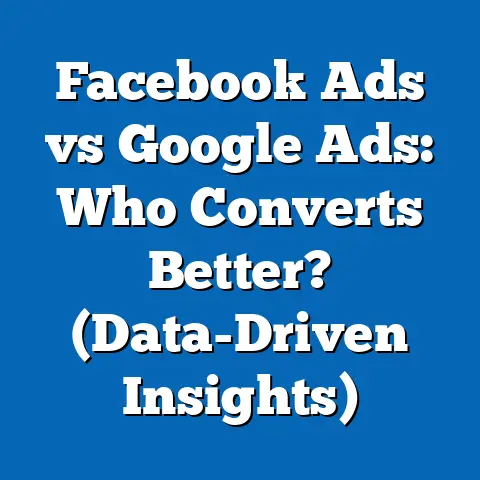Boost Dropshipping Profits with Facebook Ads (Expert Tactics)
Dropshipping has revolutionized e-commerce, offering an accessible entry point for entrepreneurs eager to start their own online businesses. The beauty of dropshipping lies in its simplicity: you don’t need to invest in inventory or manage shipping logistics. Instead, you partner with suppliers who handle these aspects, allowing you to focus on marketing and customer service.
I remember when I first stumbled upon dropshipping. I was intrigued by the idea of running an online store without the headache of inventory management. I quickly realized, however, that success in this model hinges on effective marketing. That’s where Facebook Ads come in.
Facebook Ads offer an incredibly powerful platform for reaching targeted audiences, driving traffic to your dropshipping store, and ultimately boosting sales. With its sophisticated targeting capabilities and diverse ad formats, Facebook Ads can help you connect with potential customers who are most likely to be interested in your products.
In this article, I’ll walk you through everything you need to know, from setting up your ad account to crafting compelling ad content, implementing advanced targeting strategies, and analyzing ad performance. Whether you’re a complete beginner or an experienced marketer, you’ll find valuable insights and actionable tips to help you achieve your dropshipping goals.
This guide will cover:
- Understanding Facebook Ads for Dropshipping: Learn the fundamentals of Facebook Ads and how they can be tailored for dropshipping success.
- Setting Up Your Facebook Ads Account: A step-by-step guide to getting your account ready for action.
- Crafting Compelling Ad Content: Discover the secrets to writing ad copy and creating visuals that grab attention.
- Advanced Targeting Strategies: Unlock the power of Custom and Lookalike Audiences to reach the right customers.
- Ad Budgeting and Bidding Strategies: Learn how to set a budget and optimize your bids for maximum ROI.
- Analyzing Ad Performance: Master the art of tracking and interpreting your ad metrics.
- Scaling Successful Campaigns: Take your winning ads to the next level and expand your reach.
So, buckle up and get ready to dive into the world of Facebook Ads for dropshipping. Let’s turn those clicks into conversions and watch your profits soar!
Section 1: Understanding Facebook Ads for Dropshipping
Facebook Ads are a cornerstone of modern digital marketing, and for good reason. They offer unparalleled reach, targeting precision, and a wide range of creative formats, making them an ideal tool for businesses of all sizes – especially those in the dropshipping world.
What are Facebook Ads and How Do They Work?
At its core, Facebook Ads is a paid advertising platform that allows you to display ads to users on Facebook, Instagram, Messenger, and the Audience Network (a collection of websites and apps that partner with Facebook). These ads can take various forms, from simple image ads to engaging video ads and interactive carousel ads.
The magic of Facebook Ads lies in its sophisticated auction system. When you create an ad, you’re essentially bidding against other advertisers to show your ad to a specific audience. Facebook’s algorithm takes several factors into account, including your bid amount, ad quality, and estimated action rates (the likelihood that users will click on your ad or convert).
The advertiser with the highest overall “value” wins the auction and gets their ad displayed to the target audience. This ensures that users see relevant and engaging ads, while advertisers get the opportunity to reach potential customers who are most likely to be interested in their products or services.
The Importance of Audience Targeting in Dropshipping
In dropshipping, effective audience targeting is paramount. Since you’re not limited by physical inventory constraints, you can theoretically sell to anyone, anywhere. However, this also means that you need to be laser-focused on identifying and reaching the right customers.
Facebook Ads excels in this area, offering a wealth of targeting options that allow you to narrow down your audience based on:
- Demographics: Age, gender, location, education, relationship status, and more.
- Interests: Hobbies, activities, pages they’ve liked, and topics they follow.
- Behaviors: Purchase history, device usage, travel habits, and other online activities.
- Connections: People who like your page, friends of people who like your page, or people who have interacted with your ads.
By combining these targeting options, you can create highly specific audiences that are more likely to be interested in your dropshipping products. For example, if you’re selling yoga mats, you can target women aged 25-45 who live in the United States, are interested in yoga and fitness, and have purchased similar products online in the past.
I once worked with a dropshipping client who was selling eco-friendly water bottles. Initially, they were targeting a broad audience with limited success. After refining their targeting to focus on environmentally conscious consumers who were interested in outdoor activities and sustainable living, their ad performance skyrocketed. Their click-through rate (CTR) doubled, and their conversion rate tripled!
Leveraging Different Ad Formats for Dropshipping
Facebook Ads offers a variety of ad formats, each with its own strengths and weaknesses. Choosing the right format for your dropshipping products is crucial for maximizing engagement and driving conversions. Here’s a quick overview of some of the most popular ad formats:
- Image Ads: Simple and effective, image ads are ideal for showcasing your products with visually appealing images.
- Video Ads: Engaging and dynamic, video ads can capture attention and tell a compelling story about your brand or product.
- Carousel Ads: Allow you to display multiple images or videos in a single ad, making them perfect for showcasing a range of products or highlighting different features of a single product.
- Collection Ads: Designed for mobile shopping, collection ads feature a hero image or video followed by a selection of related products, making it easy for users to browse and purchase.
- Instant Experience Ads: Full-screen, interactive ads that load instantly on mobile devices, providing an immersive and engaging experience for users.
The best ad format for your dropshipping products will depend on your specific goals and target audience. Experiment with different formats to see what works best for you. I often recommend starting with image ads and then testing video ads and carousel ads to see if they improve your performance.
Statistics and Case Studies
The effectiveness of Facebook Ads for dropshipping is well-documented. Here are a few statistics and case studies that highlight the potential:
- Reach: Facebook has over 2.9 billion monthly active users, providing an enormous audience for your ads.
- Targeting: Facebook’s advanced targeting options allow you to reach specific demographics, interests, and behaviors.
- ROI: Studies have shown that businesses can achieve a significant return on investment (ROI) with Facebook Ads, with some reporting ROIs of 3x or higher.
- Case Study: A dropshipping store selling pet supplies increased their sales by 40% after implementing a targeted Facebook Ads campaign.
These statistics and case studies demonstrate the power of Facebook Ads when used strategically. By understanding the platform’s features and implementing effective targeting and creative strategies, you can unlock significant growth potential for your dropshipping business.
Key Takeaway: Facebook Ads offer a powerful platform for reaching targeted audiences and driving traffic to your dropshipping store. Understanding the platform’s features, targeting options, and ad formats is crucial for success. Next, we’ll delve into setting up your Facebook Ads account.
Section 2: Setting Up Your Facebook Ads Account
Before you can start running ads and raking in those dropshipping profits, you need to set up your Facebook Ads account properly. This section will guide you through the essential steps to get your account ready for action.
Step-by-Step Guide to Setting Up Your Facebook Ads Account
- Create a Facebook Page: If you don’t already have one, create a Facebook Page for your dropshipping business. This page will serve as the identity for your ads and will be the place where users can learn more about your brand and products.
- Go to Ads Manager: Navigate to Facebook Ads Manager by clicking on the “Create Ads” option in the drop-down menu on the top right corner of your Facebook profile. Alternatively, you can go directly to
facebook.com/adsmanager. - Create an Ad Account: If you don’t already have an ad account, you’ll be prompted to create one. Follow the on-screen instructions to set up your ad account, providing your business information, time zone, and currency.
- Add Payment Information: Add your payment information to your ad account. You can use a credit card, debit card, or PayPal account.
- Link Your Facebook Page: Link your Facebook Page to your ad account. This will allow you to run ads on behalf of your page.
The Importance of a Business Manager Account
While you can run ads directly from your ad account, I highly recommend creating a Business Manager account. Business Manager is a centralized platform that allows you to manage multiple ad accounts, pages, and users in one place. This is particularly useful if you plan to scale your dropshipping business or work with a team.
Here are some of the key advantages of using Business Manager:
- Centralized Management: Manage all your Facebook assets (ad accounts, pages, pixels, etc.) in one place.
- User Roles and Permissions: Assign different roles and permissions to team members, ensuring that everyone has the appropriate level of access.
- Enhanced Security: Protect your business assets with two-factor authentication and other security features.
- Scalability: Easily manage multiple ad accounts and pages as your business grows.
To create a Business Manager account, go to business.facebook.com and follow the on-screen instructions. Once you’ve created your account, you can add your ad account and Facebook Page to it.
Installing the Facebook Pixel on Your Dropshipping Website
The Facebook Pixel is a small snippet of code that you place on your dropshipping website. It tracks user behavior on your site, such as page views, add-to-carts, and purchases. This data is then used to:
- Track Conversions: Measure the effectiveness of your Facebook Ads by tracking the number of conversions (e.g., purchases) that result from your ads.
- Optimize Ads: Improve the performance of your ads by optimizing them for conversions.
- Create Custom Audiences: Create Custom Audiences based on website visitors, allowing you to retarget them with relevant ads.
- Create Lookalike Audiences: Create Lookalike Audiences based on your website visitors or customers, allowing you to find new customers who are similar to your existing ones.
Installing the Facebook Pixel is a crucial step in setting up your Facebook Ads account. To install the pixel, follow these steps:
- Go to Events Manager: In Facebook Ads Manager, click on the “Events Manager” tab.
- Create a Pixel: Click on the “Connect Data Sources” button and select “Web.” Follow the on-screen instructions to create a pixel.
- Install the Pixel Code: Copy the pixel code and paste it into the
<head>section of your website’s code. If you’re using a platform like Shopify or WooCommerce, there are often plugins or integrations that make it easy to install the pixel.
Once you’ve installed the pixel, make sure to verify that it’s working correctly by testing it with the Facebook Pixel Helper Chrome extension.
I can’t stress enough how important the Facebook Pixel is. It’s the foundation for tracking your ad performance and optimizing your campaigns. Without it, you’re essentially flying blind.
Key Takeaway: Setting up your Facebook Ads account correctly is essential for success. Create a Business Manager account, install the Facebook Pixel on your website, and link your Facebook Page to your ad account. Now that your account is set up, let’s move on to crafting compelling ad content.
Section 3: Crafting Compelling Ad Content
Now that you have your Facebook Ads account set up, it’s time to create some compelling ad content that will grab your target audience’s attention and drive them to your dropshipping store. This section will cover the essential elements of effective ad copy and visuals.
The Critical Elements of Effective Ad Copy
Your ad copy is the written text that accompanies your ad’s image or video. It’s your opportunity to communicate your message, highlight the benefits of your product, and persuade users to click on your ad. Here are some key elements of effective ad copy:
- Headline: The headline is the first thing that users will see, so it needs to be attention-grabbing and relevant. Use strong verbs, numbers, and questions to pique interest.
- Description: The description provides more detail about your product or offer. Highlight the key benefits and features, and address any potential concerns or objections.
- Call to Action (CTA): The CTA tells users what you want them to do next. Use clear and concise language, such as “Shop Now,” “Learn More,” or “Get Yours Today.”
Here are some tips for writing engaging ad copy that resonates with your target audience:
- Know Your Audience: Understand their needs, wants, and pain points. Use language that they can relate to and address their specific concerns.
- Highlight the Benefits: Focus on the benefits of your product, rather than just the features. Explain how it will solve their problems or improve their lives.
- Use Strong Verbs: Use action-oriented verbs that create a sense of urgency and excitement.
- Keep it Concise: People have short attention spans, so keep your ad copy brief and to the point.
- Use Social Proof: Include testimonials, reviews, or ratings to build trust and credibility.
- Test Different Variations: A/B test different headlines, descriptions, and CTAs to see what works best.
I’ve found that using a question in the headline can be a great way to engage users. For example, if you’re selling a product that helps people sleep better, you could use a headline like “Tired of Tossing and Turning All Night?” This will immediately grab the attention of people who are struggling with sleep problems.
The Importance of High-Quality Visuals
In addition to compelling ad copy, you also need high-quality visuals that will capture attention and showcase your products in the best possible light. Here are some tips for creating or sourcing attention-grabbing images and videos for your ads:
- Use High-Resolution Images: Make sure your images are clear, crisp, and high-resolution. Avoid blurry or pixelated images.
- Showcase Your Products in Action: Use images or videos that show your products being used in real-life situations. This will help users visualize themselves using your products.
- Use Lifestyle Imagery: Use images that depict a lifestyle that your target audience aspires to. This will help them connect with your brand on an emotional level.
- Use Product Demos: Create videos that demonstrate how your products work and highlight their key features.
- Use User-Generated Content: Feature images or videos that have been created by your customers. This is a great way to build trust and credibility.
If you’re not a professional photographer or videographer, there are several resources you can use to find high-quality images and videos for your ads:
- Stock Photo Websites: Websites like Shutterstock, iStockphoto, and Unsplash offer a wide variety of royalty-free images and videos.
- Product Photography Services: Services like Product Photography offer professional product photography for e-commerce businesses.
- Freelance Marketplaces: Marketplaces like Fiverr and Upwork allow you to hire freelance photographers and videographers.
The Role of Storytelling in Ads
Storytelling is a powerful tool that can help you connect with your customers on an emotional level. By telling a story in your ads, you can create a more memorable and engaging experience that will resonate with your target audience.
Here are some tips for incorporating storytelling into your ads:
- Focus on the Customer: Tell a story about how your product has helped a customer solve a problem or achieve a goal.
- Use Emotion: Evoke emotions like joy, sadness, or inspiration to create a connection with your audience.
- Keep it Authentic: Be genuine and authentic in your storytelling. Avoid using overly salesy or promotional language.
- Use Visuals: Use images or videos that help tell your story.
- Keep it Concise: Keep your story brief and to the point.
I remember seeing an ad for a dropshipping store that was selling hiking boots. The ad featured a video of a group of friends hiking through a beautiful mountain range. The video showed them laughing, exploring, and enjoying the outdoors. The ad didn’t focus on the features of the boots, but rather on the experience of hiking and the joy of spending time with friends. This ad was incredibly effective because it told a story that resonated with the target audience.
Key Takeaway: Crafting compelling ad content is essential for driving traffic and conversions. Focus on writing engaging ad copy, using high-quality visuals, and incorporating storytelling into your ads. Next, we’ll explore advanced targeting strategies that will help you reach the right customers.
Section 4: Advanced Targeting Strategies
While basic demographic and interest targeting can be effective, advanced targeting strategies can take your Facebook Ads to the next level. This section will delve into Custom Audiences and Lookalike Audiences, two powerful tools for reaching highly targeted customers.
Custom Audiences: Reaching Your Existing Customers and Website Visitors
Custom Audiences allow you to target people who have already interacted with your business, either online or offline. This is a highly effective way to re-engage potential customers who have shown interest in your products or brand.
You can create Custom Audiences based on several sources:
- Website Visitors: Target people who have visited your website or specific pages on your website. This is a great way to retarget people who have viewed your products but haven’t made a purchase.
- Customer Lists: Upload a list of your customer email addresses or phone numbers to target your existing customers. This is a great way to promote new products or offer special deals to your loyal customers.
- App Activity: Target people who have used your mobile app.
- Engagement: Target people who have interacted with your Facebook Page, ads, or videos. This is a great way to re-engage people who have shown interest in your brand.
To create a Custom Audience, follow these steps:
- Go to Audiences: In Facebook Ads Manager, click on the “Audiences” tab.
- Create a Custom Audience: Click on the “Create Audience” button and select “Custom Audience.”
- Choose Your Source: Select the source you want to use to create your Custom Audience (e.g., Website, Customer List, Engagement).
- Follow the On-Screen Instructions: Follow the on-screen instructions to create your Custom Audience.
I’ve found that creating a Custom Audience of website visitors who have viewed a specific product but haven’t added it to their cart is a highly effective retargeting strategy. You can then show these users ads that highlight the benefits of the product and offer them a special discount to encourage them to complete their purchase.
Lookalike Audiences: Finding New Customers Similar to Your Existing Buyers
Lookalike Audiences allow you to find new customers who are similar to your existing buyers. This is a powerful way to expand your reach and target people who are most likely to be interested in your products.
To create a Lookalike Audience, you need to have a source audience. This can be a Custom Audience, a Facebook Page audience, or a website audience. Facebook will then analyze the characteristics of your source audience and find new people who share similar traits.
To create a Lookalike Audience, follow these steps:
- Go to Audiences: In Facebook Ads Manager, click on the “Audiences” tab.
- Create a Lookalike Audience: Click on the “Create Audience” button and select “Lookalike Audience.”
- Choose Your Source: Select the source audience you want to use to create your Lookalike Audience.
- Choose Your Location: Select the location you want to target with your Lookalike Audience.
- Choose Your Audience Size: Select the size of your Lookalike Audience. A smaller audience will be more similar to your source audience, while a larger audience will be less similar.
- Create Your Audience: Click on the “Create Audience” button to create your Lookalike Audience.
I recommend starting with a smaller Lookalike Audience (e.g., 1-2%) and then gradually increasing the size as you optimize your campaigns. You can also create multiple Lookalike Audiences based on different source audiences to test which ones perform best.
Retargeting Strategies: Re-Engaging Potential Customers
Retargeting is the process of showing ads to people who have already interacted with your business. This is a highly effective way to re-engage potential customers who didn’t convert initially.
Here are some common retargeting strategies:
- Website Retargeting: Show ads to people who have visited your website or specific pages on your website.
- Product Retargeting: Show ads for specific products that people have viewed on your website.
- Cart Abandonment Retargeting: Show ads to people who have added products to their cart but haven’t completed their purchase.
- Engagement Retargeting: Show ads to people who have interacted with your Facebook Page, ads, or videos.
When creating retargeting ads, make sure to:
- Personalize Your Message: Use personalized messaging that addresses the specific actions that people have taken on your website or Facebook Page.
- Offer Incentives: Offer discounts, free shipping, or other incentives to encourage people to convert.
- Use Urgency: Create a sense of urgency by using phrases like “Limited Time Offer” or “While Supplies Last.”
Retargeting is a crucial part of any successful Facebook Ads strategy. By re-engaging potential customers who have already shown interest in your business, you can significantly increase your conversion rates and boost your dropshipping profits.
Key Takeaway: Advanced targeting strategies like Custom Audiences and Lookalike Audiences can help you reach highly targeted customers and improve your ad performance. Retargeting is a crucial part of any successful Facebook Ads strategy. Next, we’ll discuss ad budgeting and bidding strategies.
Section 5: Ad Budgeting and Bidding Strategies
Setting the right budget and choosing the right bidding strategy are crucial for maximizing your return on ad spend (ROAS) and achieving your dropshipping goals. This section will cover the different budgeting options available and provide insights into optimizing your bids for better performance.
Budgeting Options: Daily vs. Lifetime Budget
Facebook Ads offers two main budgeting options:
- Daily Budget: A daily budget sets the average amount you’re willing to spend each day on your ad campaign. Facebook will try to spend close to your daily budget each day, but it may spend slightly more or less depending on the performance of your ads.
- Lifetime Budget: A lifetime budget sets the total amount you’re willing to spend on your ad campaign over its entire duration. Facebook will try to spend your lifetime budget evenly over the duration of your campaign.
The best budgeting option for you will depend on your specific goals and circumstances. Here are some general guidelines:
- Daily Budget: Use a daily budget if you want to run your ads continuously and have a consistent flow of traffic and conversions.
- Lifetime Budget: Use a lifetime budget if you want to run your ads for a specific period of time and have a limited budget.
When starting out, I often recommend using a daily budget to test your ads and optimize your campaigns. Once you’ve found a winning ad, you can then switch to a lifetime budget to scale your campaign.
Setting a Budget Based on Business Goals and Expected ROAS
The amount you should spend on Facebook Ads will depend on your business goals and your expected return on ad spend (ROAS). Here’s a simple formula for calculating your ideal ad budget:
Ad Budget = (Desired Revenue / Average Order Value) * Cost Per Acquisition (CPA)
For example, if you want to generate $10,000 in revenue, your average order value is $50, and your target CPA is $10, your ideal ad budget would be:
Ad Budget = ($10,000 / $50) * $10 = $2,000
This means you should aim to spend $2,000 on Facebook Ads to generate $10,000 in revenue.
Of course, this is just a guideline. You may need to adjust your budget based on your specific circumstances and the performance of your ads.
Bidding Strategies: Manual vs. Automatic Bidding
Facebook Ads offers two main bidding strategies:
- Manual Bidding: Manual bidding allows you to set your own bids for each ad set. This gives you more control over your ad spend, but it also requires more monitoring and optimization.
- Automatic Bidding: Automatic bidding allows Facebook to automatically set your bids for you. This is a more hands-off approach, but it can be less precise than manual bidding.
There are several different types of automatic bidding strategies:
- Lowest Cost: Facebook will try to get you the lowest possible cost per result.
- Cost Cap: Facebook will try to get you the lowest possible cost per result, while staying within your specified cost cap.
- Target Cost: Facebook will try to get you the average cost per result that you specify.
- Bid Cap: Facebook will try to get you the most results possible, while staying within your specified bid cap.
- Value Optimization: Facebook will try to get you the highest possible return on ad spend (ROAS).
When starting out, I recommend using automatic bidding to let Facebook optimize your bids for you. Once you’ve gained more experience, you can then switch to manual bidding to have more control over your ad spend.
Here are some tips for optimizing your bids for better performance:
- Monitor Your Performance: Regularly monitor your ad performance to see which ads are performing well and which ones are not.
- Adjust Your Bids: Adjust your bids based on your performance data. Increase your bids for ads that are performing well and decrease your bids for ads that are not.
- Use A/B Testing: A/B test different bidding strategies to see which one works best for you.
Budgeting and bidding are crucial aspects of Facebook Ads. By setting the right budget and choosing the right bidding strategy, you can maximize your ROAS and achieve your dropshipping goals.
Key Takeaway: Choose the right budgeting option and bidding strategy for your specific goals and circumstances. Monitor your performance and adjust your bids accordingly. Next, we’ll discuss how to analyze your ad performance effectively.
Section 6: Analyzing Ad Performance
Analyzing your ad performance is crucial for understanding what’s working and what’s not. This section will cover the key performance indicators (KPIs) to monitor and provide tips on using Facebook Ads Manager to analyze your ad performance effectively.
Key Performance Indicators (KPIs) to Monitor
Here are some of the most important KPIs to monitor for your Facebook Ads:
- Impressions: The number of times your ad was shown to users.
- Reach: The number of unique users who saw your ad.
- Click-Through Rate (CTR): The percentage of users who clicked on your ad after seeing it. A high CTR indicates that your ad is relevant and engaging to your target audience.
- Cost Per Click (CPC): The average cost you paid for each click on your ad. A low CPC indicates that your ad is efficient and cost-effective.
- Conversion Rate: The percentage of users who completed a desired action (e.g., purchase) after clicking on your ad. A high conversion rate indicates that your landing page is effective and your offer is compelling.
- Cost Per Acquisition (CPA): The average cost you paid for each conversion. A low CPA indicates that your ad is generating a good return on investment (ROI).
- Return on Ad Spend (ROAS): The amount of revenue you generated for every dollar you spent on ads. A high ROAS indicates that your ad is highly profitable.
By monitoring these KPIs, you can get a clear picture of how your ads are performing and identify areas for improvement.
Using Facebook Ads Manager to Analyze Ad Performance
Facebook Ads Manager provides a wealth of data and tools for analyzing your ad performance. Here are some tips for using Ads Manager effectively:
- Customize Your Columns: Customize the columns in Ads Manager to show the KPIs that are most important to you. This will make it easier to quickly see how your ads are performing.
- Use Filters: Use filters to narrow down your data and focus on specific ad sets, campaigns, or time periods.
- Use Breakdowns: Use breakdowns to segment your data by demographics, placement, or device. This can help you identify trends and insights that you might otherwise miss.
- Use Reports: Use reports to generate custom reports that show your ad performance over time. This can help you track your progress and identify long-term trends.
I often use the “Placement” breakdown to see how my ads are performing on different platforms (e.g., Facebook, Instagram, Audience Network). This allows me to optimize my ad placements and focus on the platforms that are generating the best results.
A/B Testing Different Ad Variations
A/B testing is the process of testing different variations of your ads to see which ones perform best. This is a crucial part of optimizing your campaigns and improving your ad performance.
Here are some common elements to A/B test:
- Headline: Test different headlines to see which ones grab the most attention.
- Description: Test different descriptions to see which ones are most persuasive.
- Image/Video: Test different images and videos to see which ones are most engaging.
- Call to Action: Test different CTAs to see which ones generate the most conversions.
- Targeting: Test different targeting options to see which ones reach the most relevant audience.
To A/B test your ads, create two or more variations of your ad and run them simultaneously. Then, monitor the performance of each variation and see which one performs best. Once you’ve identified a winner, you can then use that variation as your control and test other variations against it.
Ongoing Analysis and Adjustment of Ad Strategies
Analyzing your ad performance is not a one-time task. It’s an ongoing process that requires constant monitoring and adjustment. As your business evolves and your target audience changes, you’ll need to adapt your ad strategies accordingly.
Here are some tips for ongoing analysis and adjustment:
- Set Goals: Set clear goals for your ad campaigns and track your progress towards those goals.
- Monitor Trends: Monitor industry trends and adapt your ad strategies accordingly.
- Stay Updated: Stay updated on the latest Facebook Ads features and best practices.
- Be Flexible: Be flexible and willing to experiment with new strategies.
By continuously analyzing your ad performance and adjusting your strategies, you can maximize your profitability and achieve your dropshipping goals.
Key Takeaway: Monitor your KPIs, use Facebook Ads Manager effectively, A/B test different ad variations, and continuously analyze and adjust your ad strategies. Next, we’ll discuss how to scale your successful campaigns.
Section 7: Scaling Successful Campaigns
Once you’ve found a winning ad campaign that’s generating a positive ROAS, it’s time to scale it up and reach even more customers. This section will cover strategies for scaling your Facebook Ads campaigns while maintaining ad quality and performance.
Strategies for Scaling Facebook Ads Campaigns
Here are some common strategies for scaling your Facebook Ads campaigns:
- Increase Your Ad Spend: The simplest way to scale your campaigns is to increase your ad spend. However, be careful not to increase your ad spend too quickly, as this can negatively impact your performance.
- Expand Your Target Audience: Expand your target audience by adding new interests, behaviors, or demographics. This will allow you to reach more potential customers who are similar to your existing buyers.
- Create Lookalike Audiences: Create Lookalike Audiences based on your best-performing Custom Audiences. This will allow you to find new customers who are highly likely to be interested in your products.
- Diversify Your Ad Placements: Diversify your ad placements by running ads on different platforms (e.g., Facebook, Instagram, Audience Network). This will allow you to reach a broader audience and potentially lower your costs.
- Explore New Ad Formats: Explore new ad formats (e.g., video ads, carousel ads, collection ads) to see if they can generate better results than your existing ad formats.
When scaling your campaigns, it’s important to monitor your performance closely and make adjustments as needed.
Maintaining Ad Quality and Performance While Scaling
As you scale your campaigns, it’s important to maintain ad quality and performance. Here are some tips for doing so:
- Monitor Your KPIs: Continuously monitor your KPIs (e.g., CTR, CPC, Conversion Rate, CPA, ROAS) to see how your ads are performing.
- Optimize Your Ads: Optimize your ads by A/B testing different variations and making adjustments based on your performance data.
- Refresh Your Ads: Refresh your ads by creating new variations and rotating them regularly. This will help prevent ad fatigue and keep your ads engaging.
- Monitor Your Ad Frequency: Monitor your ad frequency (the average number of times each user sees your ad) to make sure you’re not overwhelming your audience.
Diversifying Ad Placements and Exploring New Ad Formats
Diversifying your ad placements and exploring new ad formats can help you reach a broader audience and potentially lower your costs.
Here are some common ad placements:
- Facebook Feed: The most common ad placement, shown in the news feed on Facebook.
- Instagram Feed: Shown in the news feed on Instagram.
- Facebook Marketplace: Shown in the Marketplace section on Facebook.
- Facebook Stories: Shown in the Stories section on Facebook.
- Instagram Stories: Shown in the Stories section on Instagram.
- Audience Network: Shown on websites and apps that partner with Facebook.
Here are some common ad formats:
- Image Ads: Simple and effective, image ads are ideal for showcasing your products with visually appealing images.
- Video Ads: Engaging and dynamic, video ads can capture attention and tell a compelling story about your brand or product.
- Carousel Ads: Allow you to display multiple images or videos in a single ad, making them perfect for showcasing a range of products or highlighting different features of a single product.
- Collection Ads: Designed for mobile shopping, collection ads feature a hero image or video followed by a selection of related products, making it easy for users to browse and purchase.
- Instant Experience Ads: Full-screen, interactive ads that load instantly on mobile devices, providing an immersive and engaging experience for users.
By experimenting with different ad placements and formats, you can find new ways to reach your target audience and improve your ad performance.
Key Takeaway: Scale your successful campaigns by increasing your ad spend, expanding your target audience, creating Lookalike Audiences, diversifying your ad placements, and exploring new ad formats. Remember to maintain ad quality and performance while scaling.
Conclusion
Facebook Ads offer a powerful platform for boosting your dropshipping profits. By understanding the platform’s features, implementing effective targeting and creative strategies, and continuously analyzing and optimizing your campaigns, you can unlock significant growth potential for your business.
In this article, I’ve shared expert tactics on how to effectively use Facebook Ads to enhance your dropshipping profits. We’ve covered everything from setting up your ad account to crafting compelling ad content, implementing advanced targeting strategies, analyzing ad performance, and scaling successful campaigns.
I encourage you to implement these tactics and experiment with your own strategies. The key to success with Facebook Ads is to be data-driven, adaptable, and always willing to learn.
The future of dropshipping is bright, and effective advertising will play a crucial role in achieving success. By mastering Facebook Ads, you can position yourself for long-term growth and profitability in the exciting world of e-commerce.
So, go out there, create some amazing ads, and watch your dropshipping profits soar! Remember, the journey of a thousand clicks begins with a single ad. Good luck!






